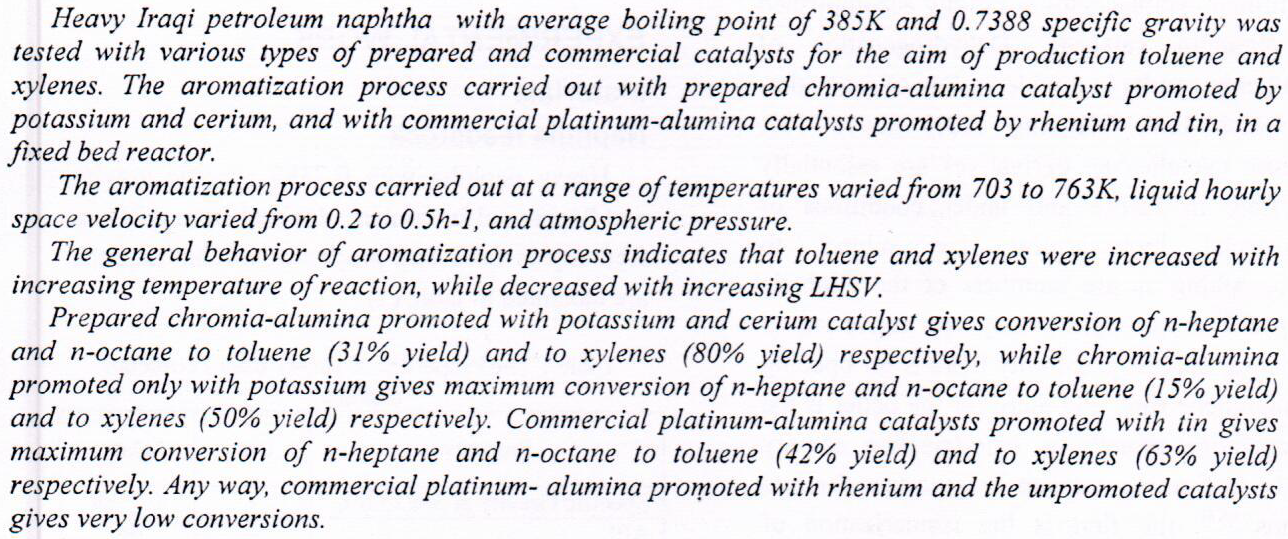
Catalytic reforming of naphtha occupies an important issue in refineries for obtaining high octane gasoline and aromatic compounds, which are the basic materials of petrochemical industries. In this study, a novel of design parameters for industrial continuous catalytic reforming reactors of naphtha is proposed to increase the aromatics and hydrogen productions. Improving a rigorous mathematical model for industrial catalytic reactors of naphtha is studied here based on industrial data applying a new kinetic and deactivation model. The optimal design variables are obtained utilizing the optimization process in order to build the model with high accuracy and such design parameters are then applied to get the best configuration of this pro
... Show MoreAtmospheric residue fluid catalytic cracking was selected as a probe reaction to test the catalytic performance of modified NaY zeolites and prepared NaY zeolites. Modified NaY zeolites have been synthesized by simple ion exchange methods. Three samples of modified zeolite Y have been obtained by replacing the sodium ions in the original sample with lanthanum and the weight percent added are 0.28, 0.53, and 1.02 respectively. The effects of addition of lanthanum to zeolite Y in different weight percent on the cracking catalysts were investigated using an experimental laboratory plant scale of fluidized bed reactor.
The experiments have been performed with weight hourly space velocity (WHSV) range of 6 to 24 h
... Show MoreThe oxidation desulphurization assisted by ultrasound waves was applied to the desulphurization of heavy naphtha. Hydrogen peroxide and acetic acid were used as oxidants, ultrasound waves as phase dispersion, and activated carbon as solid adsorbent. When the oxidation desulphurization (ODS) process was followed by a solid adsorption step, the performance of overall Sulphur removal was 89% for heavy naphtha at the normal condition of pressure and temperature. The process of (ODS) converts the compounds of Sulphur to sulfoxides/ sulfones, and these oxidizing compounds can be removed by activated carbon to produce fuel with low Sulphur content. The absence of any components (hydrogen peroxide, acetic acid, ultrasound waves and activated car
... Show More (10)
(10)
Light naphtha one of the products from distillation column in oil refineries used as feedstock for gasoline production. The major constituents of light naphtha are (Normal Paraffin, Isoparaffin, Naphthene, and Aromatic). In this paper, we used zeolite (5A) with uniform pores size (5Aº) to separate normal paraffin from light naphtha, due to suitable pore size for this process and compare the behavior of adsorption with activated carbon which has a wide range of pores size (micropores and mesopores) and high surface area. The process is done in a continuous system - Fixed bed reactor- at the vapor phase with the constant conditions of flow rate 5 ml/min, temperature 180oC, pressure 1.6 bar and 100-gram weight o
... Show More (1)
(1)
Hydroisomerization of Iraqi light naphtha was studied on prepared Ni-Pt/H-mordenite catalyst at a temperature range of 220-300°C, hydrogen to hydrocarbon molar ratio of 3.7, liquid hourly space velocity (LHSV) 1 hr-1 and at atmospheric pressure.
The result shows that the hydrisomerization of light naphtha increases with the increase in reaction temperature at constant LHSV. However, above 270 0C the isomers formation decreases and the reaction is shifted towards the hydrocracking reaction, a higher octane number of naphtha was formed at 270 °C.
 (5)
(5)
One of the most important processes to obtain gasoline with high octane numbers is isomerization. In this paper, Pt/TiO2 was prepared successfully by using the sol–gel method by hydrolysis of titanium tetraisopropoxide as a titania source with ethanol and then platinum was loaded on the synthesized catalyst; the result shows that the sample prepared has a good crystallinity with a surface area of about 85 m2 /g and a pore volume of 0.1938 cm3 /g, while XRD shows that the prepared sample was anatase phase. The efect of both temperature and liquid hourly space velocity of the prepared catalyst was achieved by hydroisomerization of n-hexane in a fxed bed reactor with a temperature of 200–275 °C and LHSV 0.5–2h−1. The results show
... Show More (1)
(1)
The isomerization of n-hexane on platinum loaded acidic zeolite was studied at atmospheric pressure, H2/nC6 molar ratios of 1-4 and temperature range of 240-270ºC. The measured kinetic data were fitted to an equation based on the bifunctional mechanism and by using independently obtained dehydrogenation and adsorption data. The activation energies of protonation (ΔHpro) and the elementary isomerization step (Eact,iso) and as well as the corresponding preexponential factor were simultaneously determined. The observed values of both ΔHpro and Eact,iso are in agreement with the results of quantum-chemical calculations.
Abstract
The hydrometallurgical method was used to platinum and palladium leaching with aqua regia solution (3HCl: HNO3). The leaching experiments were designed to obtain the optimum conditions by using Taguchi method with 16 experiments at three different factors (time, temperature and solid to liquid ratio), and each factor has four different levels. In this study, leaching the powder sample of catalytic converter that contains platinum and palladium was conducted on the basis of the formation of chloro complexes platinum and palladium (PtCl62-, PdCl42-) with different concentrations in the acidic solution. The optimum condi
... Show More (26)
(26)
Carbon nanospheres (CNSs) were successfully prepared and synthesized by Catalytic Chemical Vapor Deposition (CCVD) by using camphor as carbon source only, over iron Cobalt (Fe-Co) saturated zeolite at temperature between (700 oC and 900 °C), with different concentrations of camphor, and reaction time. The synthesized CNSs were characterized using Scanning Electron Microscopy (SEM), X-ray diffraction spectroscopy (XRD), and Fourier Transform Infrared (FTIR). The carbon spheres in different sizes between 100 nm and 1000 nm were investigated. This work has done by two parts, first preparation of the metallic catalyst and second part formation CNSs by heat treatment.
 (2)
(2)

